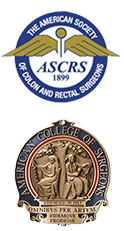Stomas (Ostomy)
The word stoma means opening. Stomas made by Colon & Rectal Surgeons are either an ileostomy or a colostomy. An ileostomy is when the last part of the small intestine, or ileum, is brought to the abdominal wall for intestinal waste to exit the body. A colostomy is when the colon is brought to the abdominal wall for the same purpose. It is estimated that approximately 120,000 new stomas will be created in the United States each year.
Stomas are either permanent as part of definitive management of a disease, or temporary, to serve as a diversion while allowing bowel downstream to heal.
Preoperative Interventions
In an effort to create an acceptable and functional stoma for both the patient and surgeon, preoperative counseling and planning are crucial. For many people the idea of a stoma is a cause of significant anxiety including fears of bad hygiene, limitation in social or athletic activities, and elimination of intimate relationships. Preoperative counseling including mental preparation through patient education and psychological support can help alleviate some of these fears and provide understanding that the presence of a stoma does not preclude a normal lifestyle. It is important to understand that a stoma can be critical intervention for symptomatic disease relief or as a life-saving measure.
An important intraoperative technical consideration involves the selection of the intestinal segment for stoma creation. In an emergent situation, when the surgeon is not sure whether the stoma will be temporary or permanent, preoperative assessment of the patient’s daily activities, disabilities and occupation can be beneficial. If there is a possibility of a permanent stoma, especially if advanced age or comorbidity, the surgeon should consider an ileostomy versus colostomy, for ease of management. On the contrary, if stoma reversal is likely, intestinal length should be preserved, especially if there is a history of chronic diarrhea or marginal incontinence. Loop stomas are often preferable in these instances in order to avoid a second laparotomy. When the distended colon is encountered intraoperatively, it is often difficult to assess vascularity and obtain adequate protrusion. The risk of parastomal hernia is also a concern if a large abdominal wall orifice is made to accommodate the colon. In this instance, it is beneficial to decompress the colon prior to maturation.
Skin irritation
Mild dermatitis often occurs as the result of irritation, inflammation, and skin breakdown caused by contact with waste. It is more frequently associated with ileostomies because of the acidic content of the small bowel. Skin breakdown of the around the stoma may also result from a skin allergy, best treated by identification and removal of the offending substance, or trauma secondary to frequent appliance changes or external accessories. Management is local wound care.
Fungal irritation of the peristomal skin, secondary to overgrowth and colonization of Candida albicans, is also commonly seen. Antifungal powders are generally helpful. Abscess, fistula formation and ulcerations are usually a consequence of inflammatory bowel disease treatment of the underlying disease is the key.
Stenosis
A stenotic or strictured stoma usually occur secondary to poor blood supply, infection or retraction. Colostomy strictures behave differently from ileostomy strictures and can usually be followed expectantly, managed with dietary modification and colostomy irrigation. More aggressive measures involve stomal dilatation. When non-operative methods are unsuccessful, surgical revision is the definitive treatment.
Retraction
Retraction or pulling in of the stoma is seen in up to 6% of colostomies and 3-17% of ileostomies created. The most common reasons are weight gain after stoma formation and short length of exteriorized segment. Resulting problems include leakage and skin irritation secondary to poorly fitting stoma pouches.
Non-operative management of the retracted stoma, especially if temporary, should involve the use of a convex stoma appliance with belt. If surgical revision is required, local procedures can be performed, especially for repair of the retracted ileostomy. On occasion, abdominal operation may be necessary for colostomy revisions which require splenic flexure mobilization.
Prolapse
Stomal prolapse is most commonly observed with transverse loop colostomies, ~30%[11], but the overall rate is much lower at 7 to 11%. Initial management will include nonoperative attempts at reduction. When skin excoriation, bleeding and/or incarceration persist, surgical correction may be necessary. This is often performed as a local operation.
Parastomal Hernia
A parastomal hernia occurs around the stoma. The true incidence of parastomal hernia has been difficult to establish because of underestimation and lack of reporting. They more commonly occur after formation of sigmoid colostomy than ileostomy and overall rates range from 16 – 50%[28]. Experts have categorized risk factors into three main groups: patient variables, disease processes, and technical aspects[28]. Patient variables include smoking status, malnutrition, age and waist circumference[29]. Obesity, diabetes, ulcerative colitis, chronic obstructive airway disease, raised intra-abdominal pressure, postoperative sepsis, perioperative steroid use and malignancy are among the comorbidities associated with the development of parastomal hernias. Technical factors include emergency procedures and siting of the stoma outside of the rectus muscle which have been shown to be an independent predictor of hernias in a multivariate analysis[28].
Asymptomatic parastomal hernia does not mandate repair, as the risks of incarceration, obstruction, and strangulation are low. Mild discomfort should be treated with abdominal support and girdles. Definitive repair is indicated for incarceration, obstruction, strangulation, chronic pain or leakage. Despite the fact that local procedures can obviate the need for laparotomy and stoma relocation, recurrence rates remain high.





